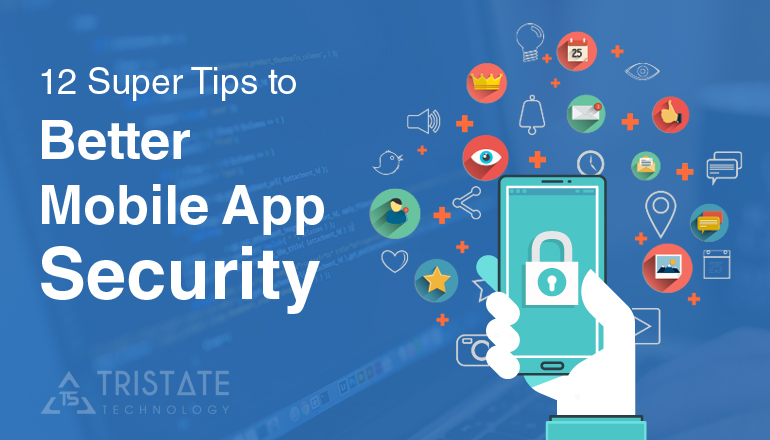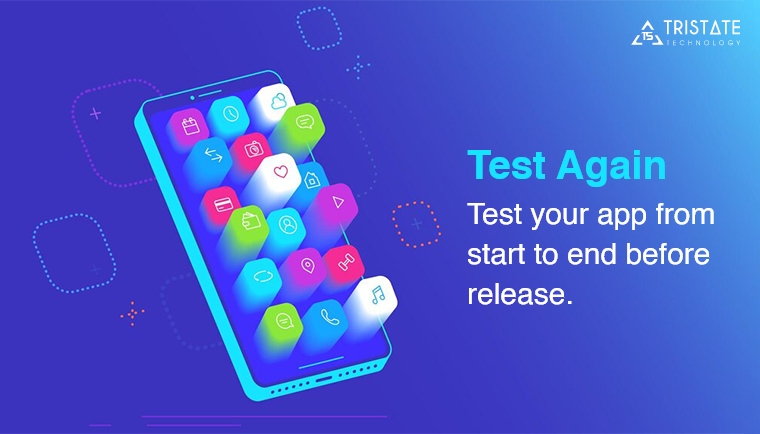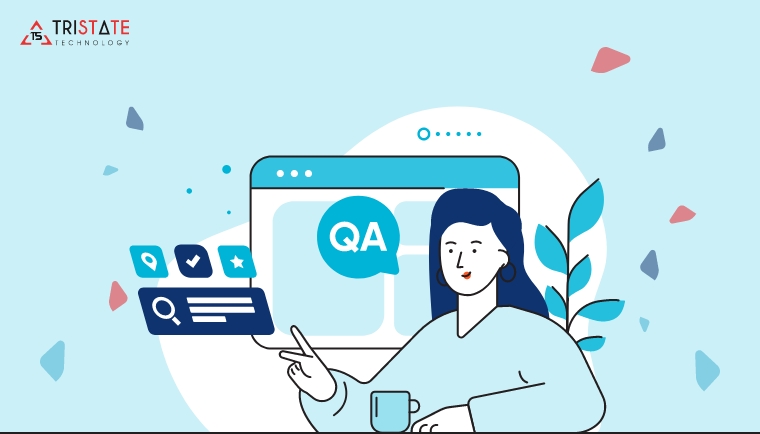Tristate AU Website
Here is what we have to say, check out latest technology news & Blog.
-
12 Super Tips to Better Mobile Application Security
05 May , 2023
Mobile application security has always been a concern.
As per the study by 2015 Trustware Global Security Report, 95% of mobile apps among the 574 breach investigations were found vulnerable. Around 35% had serious security issues and 45% had high-risk security issues.
This means mobile application security needs more efforts by the developers, development companies and even organizations looking to develop their mobile apps:
The Necessity Of Mobile Application Security In The Current Days

There are lots of individuals who consider mobile app security while making online transactions. As an app developer or business app provider, you must ensure the app you make online protects the user’s data. It should have the ability to protect the app against any malicious activities. As a business launching your app in the market brings a competitive difference that benefits you.
The upcoming section will discuss the specific digital threats or Android app security checklists that bring attention.
When it comes to cyber security, small and large enterprise business should be aware of protecting their digital assets. Nowadays, hackers always actively look for sites and apps where they can breach data. As per the 2019 reports of Verizon, more than 43% of small business owners were involved in data threats.
Let’s talk about the other side of the story because of the highest popularity of mobile apps. Small companies rely on storing crucial data on mobile devices rather than desktops. However, mobile devices are currently highly used for multiple other tasks, such as inventory control, online banking, advertising, etc.
Due to this reason, small businesses are using valuable strategies to improve mobile application security. Strong protection & security is possible when a business hires the right mobile app development company. Hiring a professional app development company is similar to investing in an insurance policy to add a strong protection layer.
When mobile application security testing checklists are done in the right way, it will eliminate the outcomes caused by data breaches such as:
- Poor revenue generation
- Losing data or sensitive information
- The bad reputation of business
- Property theft
This is how mobile app security is necessary for protecting your app. It makes you able to take your business growth to a new level. If you are still unsatisfied with the reasons, let’s look at some market statistics.
Market Statistics Report Regarding Cyber Breach
Cyber breach issues are normal, but nowadays, it brings lots of struggle for business. As per the security research, most companies have unprotected poor cyber security practices and have the highest chances of data loss.
Here we share a few surprising statistics proving mobile application security is necessary.
- More than 5.19 million individuals are using their smartphones and spend 90% of their time. Many organizations don’t consider these basic security measures.
- Around 60% of companies never changed their passwords.
- We all know 2020 was the most unpredictable year for individuals and businesses. Most of the IT works is done through remote access time. It was the time when an employee got access to 11 million files. Around two third companies were open their sensitive data to everyone.
- 43% of companies lost mobile security in 2019 because their mobile app development team asked to prioritize the market trends over security measures.
- Due to the covid lockdowns, the popularity of online banking apps is getting stronger. However, recently, the FBI warned consumers to stay far from mobile app frauds. There is a 50% rise in launching fake apps and apps that can be vulnerable to the user’s data.
Considering these statistics, you can clearly understand how important it is to take a positive approach to mobile security applications. So, if you are ready to launch the new mobile application, ensure you are equipped with the right security measures of the mobile app development security checklist. But before you move forward, let’s look at the common threats in mobile applications.
Know About The Common Mobile Application Security Threats

1. Encrypted Source Code
Billions of people buy online services and use payment cards, merchant cards, and other bank-related accessories during online transactions. Exchanging huge amounts of sensitive data yearly makes these apps a perfect target for hackers. A lot of research discovered that the vulnerabilities in mobile started from the design and its source code. As per recent studies, multiple source codes infect millions of devices and breach app security.
2. Use High-Level Authentication
The authentication practice is the most crucial part of mobile application security. Lack of authentication can also damage security measures. It can put your app at great risk. To eliminate these issues, hire a skilled professional mobile application developer.
3. Accessing 3rd Party Source Code
This is the most basic threat cause that strong strategies can incorporate. Before using the 3rd party source code, it is crucial to understand that it is unsafe to implement into your app. Some developers are there who access 3rd party source code at the highest level, causing data breaches.
4. Stay Careful When Integrating APIs
To extend the usability and functionality of the application, the developers integrate multiple third-party libraries and APIs. Undoubtedly, it makes the task easier and hassle-free, but trusting these integrated APIs might harm you. The flaws in the APIs can allow access to the attackers.
How to Make Mobile Application Security Better?
1.Secure your app’s source code
A mobile application can easily catch-up bugs and vulnerabilities through its source code.
There are many programming languages available in the industry now to develop mobile applications. Among those languages, many of them are easy-to-read like JavaScript.

So, easy to read languages can be easily targeted to infect with malware attacks. Hence, you need to add minification and obfuscation that makes it difficult to understand the language. This ensures that your mobile app source code is secure.
2.Secure your network connections

Well, your mobile application can have too many own or 3rd party API connections to make your app feature-rich and competitive.Your servers have all the data stored, so it is very much important that you secure your network connections.
How would you secure your network connection?
- By installing Firewalls
- Protect the codes from SQL injections
- Make your servers protected using SSL
- Protect your servers using passwords from unauthorized access
- Containerization should be incorporated to securely store your data
- Federation security ensures secure collaboration between various systems, networks, and organizations
Securing your mobile app back-end is equally important as its source code and design.
3.Understand platform specific limitations
Most of the time, bizzo look to develop their apps in both – iOS and Android. But, the mobile app development company has to look for all the security limitations for each of those platforms.
Now, recently, Google released its Android Security 2017 Year in Review report. As per this report, more than 7 Million apps were removed from Google Play Store because of impersonation, inappropriate content, or malware.
In the same report, Google increased the number of Android devices that received security patches by more than 30%. Based on this report, Google said that Android is equally secure as iOS.
But still, most Android app developers have this mindset that Android is less secured compared to iOS.

And, this does not stop you to look for the security limitations each platform has. Mobile app developers always need to take care of different user scenarios, encryption and password securities and even the geo-location functionality that each operating system supports. This can secure the data that each OS uses.
4.Work on API Security
As per the survey – Managing API Security Risks, Akana – 65% of respondents said that they don’t have processes for API data security. In fact, 53% said that DDoS, SQL injection, and XML bombs are their biggest API security concerns.

API is the channel that helps in communication between apps, users, and servers. Being the most important channel in the mobile applications, APIs need to be highly secure.
How would you secure APIs?
- Identify the risks APIs has
- Involve API identification, authentication, and authorization as a security level
- Double-check what data your APIs are transmitting to the app users
- Work with OAuth, HTTPS, SeaCat standardized protocols
5.Make Provisions for Data Security
Gemalto, as usual, came up with 2017 first half Breach Level Index findings where it shows 13% increase in data breaches from the last half of 2016 and a 164% increase in stolen, lost or compromised records.
This clearly states that there is more requirement to work on data security.

What can be done to improve the data security?
- Work on a data security policy/strategy to ensure each and every aspect of the data breach is considered
- Utilize SQLite Database Encryption Modules to secure the data in a sandbox
- First-level encryption across various operating systems
6.Secure the Data-in-transit
We always focus on securing front-end, back-end, and even the APIs. But, we need to also focus on securing data that is sent to the back-end from the client’s end on the network. This data have higher risks of getting affected by the security threats by other users on the network.

What can be done to secure data-in-transit?
- WPA2 Enterprise can be used in the strong enterprise network to encrypt all data being transferred across the network
- Mobile app developers can use SSL/TLS to encrypt the data-in-transit to ensure the confidentiality of users’ private data
- The certificates, SSL/TLS exchange Public Keys and those Public Keys exchange the Private Keys to secure the data
7.Prevent Unintended Data Leakage

Most of the apps ask for permissions from the users before downloading and installing the app.
Well, this is just an example of asking for data from the mobile devices. This is how most users allow their information to be used by the apps. But, this can risk the bizzo trust of their customers. So, to ensure the customers always trust the bizzo, the bizzo need to implement a highly secured process of implementing advertising and other analytics providers to not compromise their trust and boost their bizzo.
What can be done to prevent data leakage?
- Access controls can prevent data leakage by restricting the data resources
- Encryption can also be implemented
- Tokenization can help replace the most sensitive data with some unique identification symbols that are difficult to track the information within the same
- Alerts can be placed when there are chances of data being leaked
- Dynamic Data Masking prevents the sensitive data by changing the data streams
8.Use the latest cryptography techniques
Cryptography is always referred as encryption that converts the general information into some unintelligible text.
There are various Cryptography algorithms that work to encrypt the data of the mobile app users as they are highly used by various industries.

Based on the above research, the latest cryptography algorithms AES and SHA are highly secured encryption techniques. Among both of these, AES with 256-bit encryption and SHA-256 are effective in offering the security of the mobile apps.
9.Minimize storage of sensitive data
Most of the time, the personal and sensitive data is stored on the mobile devices by the mobile app users.

What mobile app developers can do to avoid this?
They can work on encrypting the data before getting them stored on the mobile devices using containers or key chains.
Most users have this habit of storing their passwords on the mobile device. To secure their passwords, cookies can be implemented.
Also, it cannot be expected from users to regularly delete the log files from the app databases. Hence, they can be set to get deleted automatically at a certain time intervals.
10.Secure Employee Devices
There are various organizations that allow employees to use their own device to work for them. Now, it becomes crucial for the organization’s IT department to ensure the security of the organization’s sensitive data on their mobile devices.

What can be done to avoid security threats on employees’ mobile devices?
- Installing a VPN (Virtual Private Network) on all the employees mobile devices to ensure security against vulnerabilities
- Installing antivirus software that restricts malicious files to be stored in their mobile devices
- Password-management can be placed in order to secure passwords at organizational levels
- Precautions need to be taken in order to prevent any critical transaction taking place in advance
- Certain functionalities need to be implanted in the employees’ devices in such a way that they have controls to access company emails, social media, and also, the logs and other sensitive data can be deleted by the IT department when the employee leaves the organization
11.Test your app rigorously
As per the report by The State of Mobile Application Security, Ponemon Institute for IBM, 65% “rush to release” app needs affects the mobile application security.
Also, Prevoty’s The Impact of Security on Development states that 43% of developers who released mobile apps with known vulnerabilities at least 80% of time as they have pushing delivery deadlines.

What can be done to avoid this?
- Penetration testing is an attack on the mobile apps to test their security performance
- Apps need to be tested manually as well as using automated testing tools to check for bugs or exceptions
- Usability testing needs to be implemented
- Give appropriate time to testing the app because it, after all, affects the trust of the customers
- Use Emulators to test your mobile app on various devices, operating systems, and browsers
12.QA with the help of Hackers
Only testing the mobile app does not ensure the security aspects of the mobile app are taken care of.
Quality Assurance is equally important to check whether the mobile app is completely secured from the security threats.

Have you ever heard that Google and many other similar companies organize Hackathons to check security issues within their products?
Well, the mobile application development companies can also do the same thing or can hire just one hacker to check for chances to break the apps, if they have the budget to do so.
Conclusion
Mobile application security has increasing demands looking at the pace technology is moving. But, the mobile application development companies or the developers need to be extra cautious to provide better mobile app security.
-

The Best Features and Revenue Models for Travel App Development
August 11, 2023 -

Looking for the Best iOS App Development Framework? Know the Difference between SwiftUI and UIKit!
July 21, 2023 -

7 Mobile App Development Ideas that are Unique and Profitable
June 23, 2023 -

What is AngularJS? Why is it the Most Demanding Web Development Framework?
June 15, 2023 -

The New Era of Software Development is Here! 10 Latest Trends to Implement
May 30, 2023
